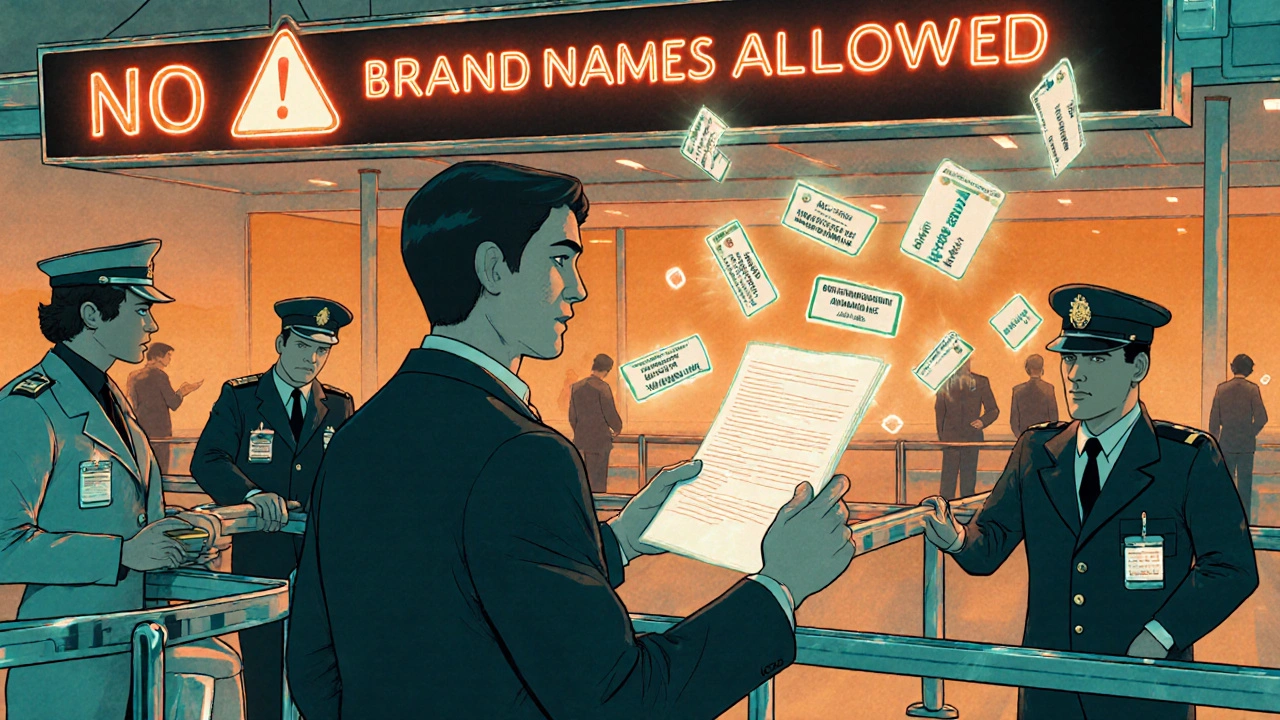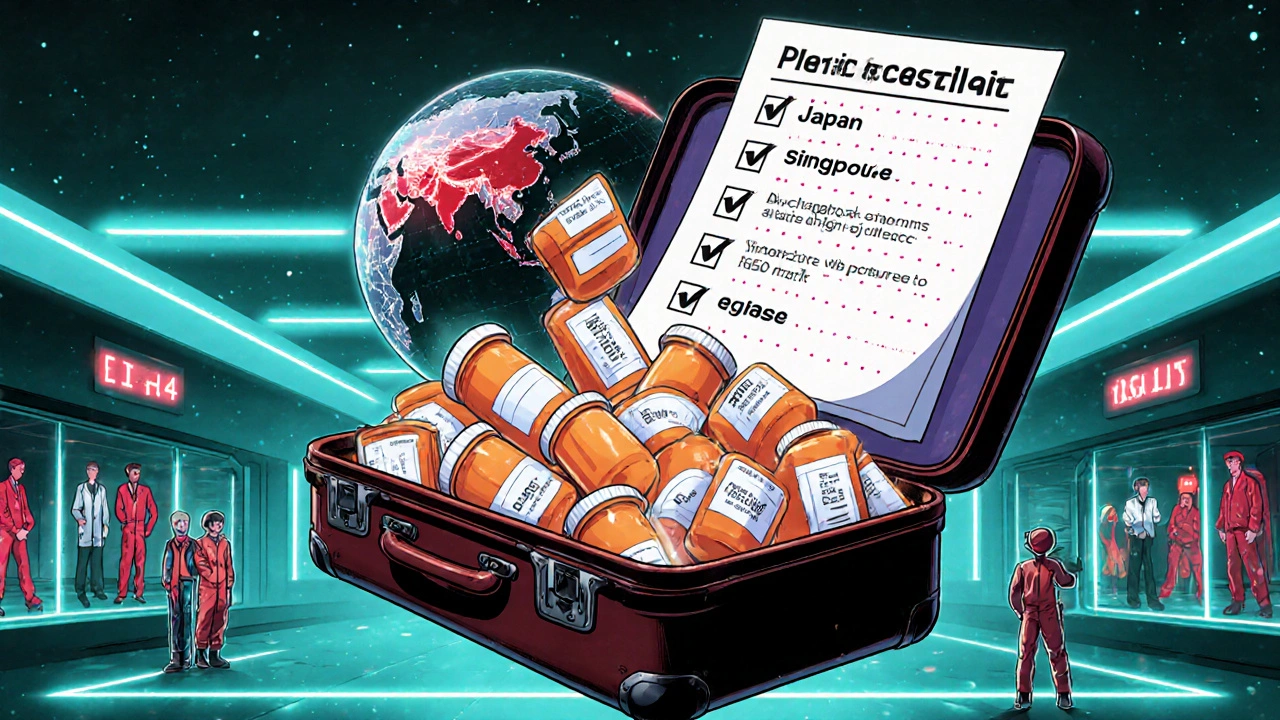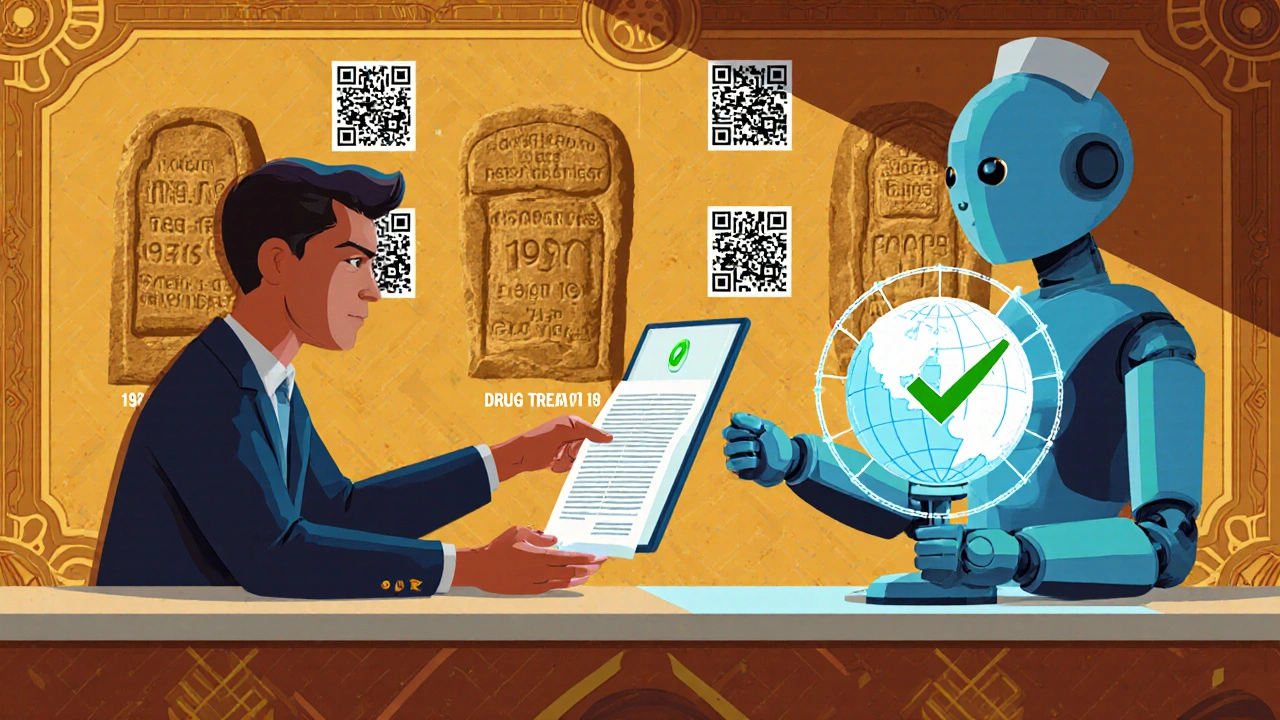Doctor’s Letter for Controlled Substances During International Travel: What You Need to Know
 Nov, 23 2025
Nov, 23 2025
Carrying prescription medications across borders isn’t as simple as tossing them in your suitcase. If you’re traveling with controlled substances - like opioids, stimulants, benzodiazepines, or ADHD medications - you could face serious trouble without the right paperwork. In 2022, over 127 travelers were detained worldwide just because their doctor’s letter was missing key details. Some spent weeks in jail. Others had their meds confiscated. This isn’t rare. It happens more often than you think.
Why You Need a Doctor’s Letter
International drug laws don’t care if you’re taking your meds for chronic pain, anxiety, or ADHD. If it’s on a controlled substance list in the country you’re visiting, you need proof it’s legal for you to have it. These rules come from three global treaties: the 1961 Single Convention on Narcotic Drugs, the 1971 Convention on Psychotropic Substances, and the 1988 UN Convention Against Illicit Traffic. Together, they cover 186 countries. Each country enforces its own version - but they all require documentation.The doctor’s letter is your legal shield. It tells border agents, customs officers, and police that you’re not smuggling drugs - you’re a patient who needs treatment. Without it, even a 30-day supply of Adderall or oxycodone can look like trafficking.
What Must Be in the Letter
A generic note from your doctor won’t cut it. The letter must include specific details, as outlined by the CDC’s 2023 Yellow Book and FDA guidelines:- Your full name and date of birth (must match your passport)
- The prescribing doctor’s full name, title, license number, clinic address, and phone number
- The generic name of each medication (not the brand name - brand names vary by country)
- The exact dosage, frequency, and route (e.g., 20 mg oral tablet, once daily)
- The medical condition being treated (e.g., “Attention Deficit Hyperactivity Disorder,” “Chronic Neuropathic Pain”)
- A clear statement: “This patient is under my care and requires this medication for legitimate medical purposes”
- The doctor’s handwritten signature and official letterhead
Many doctors skip the generic name. Big mistake. In Japan, Adderall is banned outright - even with a letter - because it contains amphetamine. But if your letter says “dextroamphetamine-amphetamine,” some countries may still allow it if the dose is within limits. Knowing the chemical name matters.
Quantity Limits and Packaging Rules
You can’t just pack a six-month supply. Most countries limit you to a 90-day personal use amount. The FDA and U.S. Customs and Border Protection (CBP) recommend no more than 90 days’ worth. Canada allows up to 100 dosage units for Schedule II-V drugs. Singapore and Malaysia cap it at 30 days - and they enforce it with jail time.Your meds must be in their original prescription bottles with the pharmacy label intact. That’s non-negotiable. If you use a pill organizer, you must carry the original containers with you - and bring a copy of the prescription. If you’re carrying multiple controlled substances, you need a separate letter for each one. One letter for all meds? Not enough.

Country-Specific Rules You Can’t Ignore
Not all countries treat medication the same way. Here’s what you need to know before booking your flight:- Japan: Adderall, Ritalin, and most stimulants are illegal, even with documentation. Valium (diazepam) is allowed only with a special permit. Check the U.S. Embassy in Tokyo’s website before you go.
- United Arab Emirates: You need pre-approval from the Ministry of Health. Submit your letter and prescription at least 30 days before arrival. No exceptions.
- Singapore and Malaysia: Exceeding a 30-day supply can lead to arrest. Even with a letter. They don’t play around.
- European Union: Most countries accept doctor’s letters from other EU members. No advance approval needed if you’re under 90 days. But keep your meds in original packaging.
- United States: If you’re returning with controlled substances, you need both the letter AND the original prescription. CBP checks this rigorously.
- Canada: Accepts doctor’s letters alone for personal use quantities. No prescription needed if you’re a Canadian resident.
ADHD medications are the most problematic. A 2023 study in the Journal of Travel Medicine found that 89% of countries require special documentation for stimulants like methylphenidate or amphetamine. Don’t assume your prescription is enough.
How to Get the Right Letter
Start early. Two months before your trip is ideal. Many doctors don’t know what’s required. A 2022 survey found that 72% of physicians fail to include the generic name or proper wording. Here’s how to make sure you get it right:- Make a list of every medication you take - including dosages and how often you take them.
- Look up the generic names. Use the FDA’s Drug Database or MedlinePlus. Write them down.
- Call your doctor’s office. Say: “I need a letter for international travel with controlled substances. I need the generic name, dosage, condition, and a statement that this is for legitimate medical use.”
- Ask if they use the CDC’s template. If not, print one from the CDC’s website and give it to them to sign.
- Get it signed on official letterhead. No photocopies. No emails. Original signature only.
- Make two copies. Keep one with you. Leave one with a trusted person at home.
And if your doctor refuses? Go to a travel medicine clinic. Many hospitals have them. They specialize in this stuff.
What Happens If You Don’t Have a Letter
You might not even make it through customs. In 2022, the INCB reported that 68% of medication-related traveler incidents were due to missing or incomplete documentation. That means nearly 7 out of 10 people who got into trouble didn’t have the right letter.Consequences vary:
- Medications confiscated
- Delayed entry - sometimes for days
- Detention and questioning
- Fines
- Criminal charges - especially in Southeast Asia and the Middle East
One traveler from the U.S. was held in a Thai jail for 17 days after carrying 60 pills of oxycodone without a letter. He had a prescription from his doctor - but no official letter. He didn’t know the difference.

Translations and Digital Documents
If your letter isn’t in English, you need a certified translation. The FDA requires this. Don’t use Google Translate. Use a professional service. Some countries, like Japan and South Korea, require documents in their native language - even if you’re carrying a U.S. letter.Telemedicine prescriptions? Accepted - if they’re signed digitally and include all required elements. The FDA updated its guidance in May 2023 to allow this. But you still need the original digital copy printed out. A screenshot on your phone won’t cut it.
What’s Changing in 2025
The world is moving toward digital documentation. The INCB launched a pilot program in 12 European countries in 2023 for a standardized digital medical certificate. The European Commission is funding a €2.4 million project to create a unified EU system - launching in late 2024. The goal? A QR code on your phone that links to your verified medical record.But until then, paper still rules. Don’t wait for tech to save you. Get your letter now.
Final Checklist Before You Fly
Before you leave, double-check this:- ✅ All medications in original bottles with pharmacy labels
- ✅ Doctor’s letter on official letterhead with signature
- ✅ Generic names listed for every drug
- ✅ Dosage, frequency, and condition clearly stated
- ✅ Letter in English or certified translation
- ✅ No more than 90-day supply (30 days for Singapore/Malaysia)
- ✅ Separate letter for each controlled substance
- ✅ Copy of the letter left with someone at home
- ✅ Contact info for your doctor included
- ✅ Verified country rules on embassy website
If you’re flying with ADHD meds, opioids, or benzodiazepines - don’t skip this. One missing detail can turn your vacation into a nightmare. It’s not paranoia. It’s policy. And it’s enforced.
Do I need a doctor’s letter if I’m just passing through a country?
Yes. Even if you’re not leaving the airport, customs officers can search your bags. If they find controlled substances without proper documentation, you can be detained - even for a layover. There are no exceptions for transit.
Can I carry my medication in my carry-on or checked luggage?
Always carry it in your carry-on. Checked bags can be lost, delayed, or opened without your knowledge. If your meds are in checked luggage and you’re denied entry, you won’t have access to them. Plus, TSA and international security screen carry-ons first - so you’ll be able to show your letter immediately if asked.
What if my doctor won’t write the letter?
Ask to speak with the office manager or nurse. Many doctors delegate this task. If they still refuse, visit a travel clinic or urgent care center that specializes in international travel. They can write the letter for a small fee. Your health isn’t worth risking a trip over.
Is a prescription enough instead of a letter?
No. A prescription alone doesn’t explain why you need the medication or confirm it’s for personal use. Border agents need context - not just a receipt. The letter is your legal explanation. The prescription is just proof of purchase.
Can I bring over-the-counter meds that contain controlled substances?
Some OTC meds outside the U.S. contain codeine, pseudoephedrine, or diazepam - substances that are controlled in other countries. Even if you bought it legally at home, it’s illegal to bring it into a country that bans it. Check the list of controlled substances for your destination. When in doubt, leave it behind.
Bartholemy Tuite
November 24, 2025 AT 04:18Man, I just got back from Japan and I didn’t know Adderall was banned there even with a letter. My doctor gave me some generic note and I thought that’d be enough. Turns out I had to get the full dextroamphetamine-amphetamine thing written out. Almost got my bag searched at Narita. Scared the hell out of me. Don’t be like me - get the letter right, or don’t bother bringing it.
Jacob McConaghy
November 25, 2025 AT 17:45Biggest thing people miss? The generic name. I had a buddy get pulled over in Dubai because his letter said 'Adderall' and not 'mixed amphetamine salts'. They thought he was smuggling street drugs. He spent 36 hours in a holding cell. Just because his doc was lazy. Don’t let your doctor cut corners - print out the CDC template and hand it to them. Tell them it’s for international travel. Most will sign it if you make it easy.
Vineeta Puri
November 26, 2025 AT 23:09As a healthcare professional from India, I cannot stress enough the importance of adhering to international medication regulations. The consequences of non-compliance are not merely administrative but can lead to severe legal ramifications, including detention and criminal prosecution. It is imperative that travelers seek guidance from certified travel medicine clinics and ensure that all documentation meets the exacting standards of the destination country’s health authorities. Your health and liberty are not worth risking due to procedural negligence.
Victoria Stanley
November 27, 2025 AT 04:20Just wanted to say THANK YOU for this post. I have ADHD and travel for work all the time. I used to just pack my pills in a pill organizer and hope for the best. After reading this, I went to my doctor, gave her the CDC template, and got my letter signed with the generic names. Now I carry two copies, my original bottles, and a printed embassy checklist. I feel like a responsible adult for once 😅
Andy Louis-Charles
November 28, 2025 AT 15:17Pro tip: If you're flying through Singapore, don’t even think about bringing more than 30 days’ worth. I saw a guy get detained last year with 45 days of gabapentin. He thought it was 'just for nerve pain' and not controlled. Turns out it’s Schedule IV there. They took his meds, fined him $5k, and banned him for 2 years. 🤦♂️
Yvonne Franklin
November 30, 2025 AT 03:58akhilesh jha
December 1, 2025 AT 08:23Why do countries even have these rules? It’s not like people are smuggling pills to sell. We’re just trying to survive. I have PTSD and take clonazepam. If I don’t have it, I can’t fly. But if I bring it, I risk jail? Sounds like the system is broken. Not me.
Jeff Hicken
December 2, 2025 AT 02:38Ugh I hate these posts. Like, why are we babying travelers? If you can’t figure out how to pack your meds without getting arrested, maybe you shouldn’t leave the house. My grandma took her insulin to Mexico in a Ziploc and nobody cared. Stop overcomplicating everything.
Douglas cardoza
December 3, 2025 AT 23:20My doctor refused to write the letter. Said it wasn’t his job. So I went to a Walgreens MinuteClinic and paid $75. They printed it on real letterhead, signed it, and even added the generic names. Took 15 minutes. Worth every penny. Don’t stress - there’s always a way.
Adam Hainsfurther
December 5, 2025 AT 17:30One thing nobody talks about: what if you’re trans and your name on your prescription doesn’t match your passport? I had to get a notarized letter from my endocrinologist explaining my transition and name change just to carry my hormones. Even then, I was questioned for 45 minutes at Heathrow. This system was built for cis, straight, white Americans. It’s not fair. But it’s the reality.
Rachael Gallagher
December 7, 2025 AT 10:24Let’s be real - this whole thing is a government scam. They want you to pay for 'travel clinics' and 'certified translations' so they can profit off your fear. The real reason they’re so strict? They don’t want you feeling better abroad. Keep you dependent on their system. I’ve seen it. The DEA, WHO, UN - all connected. Your Adderall? It’s a tool of control.
steven patiño palacio
December 7, 2025 AT 17:10Excellent breakdown. I’d only add one thing: if you’re carrying multiple controlled substances, always bring a separate letter for each. I once had a nurse at a Canadian border ask me about my oxycodone and benzodiazepine - I had one letter for both. They held me for two hours until I called my doctor to fax a second letter. Don’t make them guess. Be clear. Be thorough.
stephanie Hill
December 7, 2025 AT 22:26Did you know the FDA is working with the UN to implant microchips in prescription bottles by 2026? That’s why they’re pushing so hard for digital certificates now. They want to track every pill you take, everywhere. They’re already using AI to flag 'suspicious' medication patterns. If you’re on mood stabilizers and travel to Thailand? You’re flagged. Don’t be a lab rat.
Akash Chopda
December 9, 2025 AT 05:26They lie about the 90 day rule. I brought 120 pills to Thailand. No letter. Got away. Just hide them in shampoo bottle. No one checks. Trust me.
Sam Jepsen
December 10, 2025 AT 14:09Just flew from Vancouver to Tokyo with my ADHD meds. I had the letter, the original bottles, the generic names, the copy for home - all perfect. Customs guy looked at it, nodded, said 'Have a good trip.' No drama. It’s not hard. Do the work. Your future self will thank you.